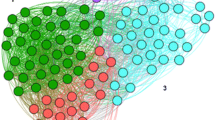Abstract
Exploring the hierarchical structure and internal correlation of chronic disease knowledge network is of great significance to distinguish conceptual terms and core directions of chronic disease area. This paper proposed a descriptive Tomographic Content Analysis method to analyze the cross-section of chronic disease knowledge network. K-core values and clustering coefficients were applied to divide the network into layers. Then vectors for each layer were constructed to calculate their cosine similarities to compare their correlation and differences. Finally, network stratification results were compared with the community modules obtained by the traditional social network analysis from a quantitative perspective. To illustrate the method, a number of 26,717 articles related to hypertension in the PubMed database were taken as examples to construct the chronic disease knowledge network. Results show that the chronic disease knowledge network can be divided into the basic layer, the middle layer and the detailed layer. The basic layer can be used to divide the main research directions of chronic diseases. The detailed layer can be used to characterize the specific research and reveal the microscopic forms of the network. The middle layer can be used to explore the network intersection and evolution paths. Compared with the traditional social network analysis method, our proposed method can obtain more in-depth and detailed hierarchical structures and internal correlations of chronic disease knowledge networks.
Access this chapter
Tax calculation will be finalised at checkout
Purchases are for personal use only
Similar content being viewed by others
References
NCG: Chronic disease management: the pioneer of online medical care. http://ncd.org.cn/Article/index/id/5641. Accessed 22 Oct 2017
Zhang, J.Z., Han, T., Wang, X.M.: Overview of complex network research and its application in library and information science. J. China Soc. Sci. Tech. Inf. 31(9), 907–914 (2012)
Liu, X., Ma, F.C., Chen, X.J., et al.: Structure and evolution of knowledge network – concept and research review. China Inf. Sci. 29(6), 801–809 (2011)
Yi, S., Choi, J.: The organization of scientific knowledge: the structural characteristics of keyword networks. Scientometrics 90(3), 1015–1026 (2012)
Carmi, S., Havlin, S., Kirkpatrick, S., et al.: A model of internet topology using k-shell decomposition. Proc. Natl. Acad. Sci. U.S.A. 104(27), 11150–11154 (2007)
Hu, C.P., Chen, G.: An exploration of hierarchical domain knowledge network and its micro-morphology based on co-word analysis with reliable relations. J. China Soc. Sci. Tech. Inf. 33(2), 130–139 (2014)
Clauset, A., Moore, C., Newman, M.E.: Hierarchical structure and the prediction of missing links in networks. Nature 453(7191), 98–101 (2008)
Sales-Pardo, M., Guimerà, R., Moreira, A.A., et al.: Extracting the hierarchical organization of complex systems. Proc. Natl. Acad. Sci. U.S.A. 104(39), 15224–15229 (2007)
Teng, G.Q., Bai, S.C., Han, S.X., et al.: Analysis on the principle of knowledge network at level based on scale-free and fractal theory. Libr. Inf. Serv. 61(14), 132–140 (2017)
Lee, K., Kim, S.Y., Kim, E.H., et al.: Comparative evaluation of bibliometric content networks by tomographic content analysis: an application to Parkinson’s disease. J. Assoc. Inf. Sci. Technol. 68(5), 1295–1307 (2016)
Blondel, V.D., Jean-Loup, G., Renaud, L., et al.: Fast unfolding of communities in large networks. J. Stat. Mech.: Theory Exp. 208(10), 155–168 (2008)
Zhang, G.Q., Zhang, G.Q., Yang, Q.F., et al.: Evolution of the internet and its cores. New J. Phys. 10(12), 123027 (2009)
Alvarez-Hamelin, J.I., Dall’Asta, L., Barrat, A., et al.: K-core decomposition of Internet graphs: hierarchies, self-similarity and measurement biases. Netw. Heterog. Media 3(2), 371–393 (2005)
Liu, J.: Overall Network Analysis Handbook: Practical Guide of UCINET Software. Truth & Wisdom Press, Shanghai (2009)
Aristotelis, K., Laura, B., Henning, H., et al.: Organizational principles of the Reactome human BioPAX model using graph theory methods. J. Complex Netw. 4(4), 604–615 (2016)
Cui, L.: Bibliographic Items Co-occurrence Matrix Builder, BICOMB 2.0. http://cid-3adcb3b569c0a509.skydnve.live.com/browse.aspx/BICOMB. Accessed 30 Sept 2017
Yang, Y., Wu, M., Cui, L.: Integration of three visualization methods based on co-word analysis. Scientometrics 90(2), 659–673 (2012)
Acknowledgment
This paper is an outcome of the international cooperation and exchange program “Research on Intelligent Home Care Platform Based on Chronic Disease Knowledge Management” (No. 71661167007) and the major international (regional) joint research project “Research on Knowledge Organization and Service Innovation in the Big Data Environments” (No. 71420107026) supported by National Nature Science Foundation of China.
Author information
Authors and Affiliations
Corresponding author
Editor information
Editors and Affiliations
Rights and permissions
Copyright information
© 2018 Springer Nature Switzerland AG
About this paper
Cite this paper
Zhou, L., An, L., Ba, Z., Li, Z. (2018). A Descriptive Tomographic Content Analysis Method in Chronic Disease Knowledge Network: An Application to Hypertension. In: Chen, H., Fang, Q., Zeng, D., Wu, J. (eds) Smart Health. ICSH 2018. Lecture Notes in Computer Science(), vol 10983. Springer, Cham. https://doi.org/10.1007/978-3-030-03649-2_30
Download citation
DOI: https://doi.org/10.1007/978-3-030-03649-2_30
Published:
Publisher Name: Springer, Cham
Print ISBN: 978-3-030-03648-5
Online ISBN: 978-3-030-03649-2
eBook Packages: Computer ScienceComputer Science (R0)




